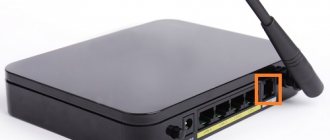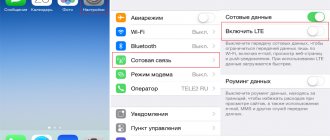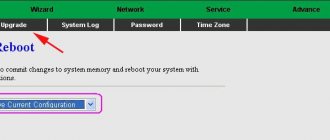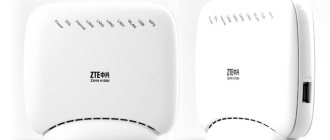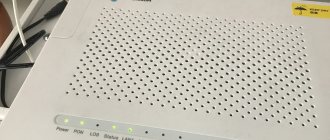Hi all! Today we will be setting up a router from the Dom.ru provider. Before we get started, I want to say a couple of important things. Firstly, the provider does not have its own routers. That is, these are the same TP-Link, D-link, ASUS, on which they simply stuck a sticker.
Secondly, such devices are additionally loaded with proprietary stripped-down firmware. In the article I will talk about the configuration - both with special firmware and with regular firmware. The process is quite simple, but if you have any difficulties or questions, write in the comments.
Speaking of difficulties! The question is often asked: what type of connection does the Dom.ru provider use? Answer: "PPPoE". To log in you will need the login and password specified in the agreement. If you have an “Interzet” provider, then you use: “IPoe” or also “PPPoE”. In any case, you need to keep at hand the contract, which contains the necessary data.
Connection
How to connect a router? The connection is quite simple. First of all, you need to find the so-called “WAN” port. It looks like a network port and always stands out from others - by color or designation (most often it is blue). You need to connect the cable provided by your provider to it.
The remaining local “LAN” ports have the same color, and you can connect any local devices there: computers, laptops, TVs, printers, CCTV cameras, etc. The connection is made using a regular network cable - a spare cord should be in the box that came with the router.
NOTE! If you use other Internet centers, then also try to find WAN and LAN ports. Typically a WAN may have a "planet" icon. LAN inputs are usually numbered.
If you configure from a phone or tablet, you can connect via Wi-Fi. To do this, you need to look under the device’s body and find the name and password for the wireless network. Usually the name duplicates the full name of the model. The password must be on a separate line. If there is no password, then find a line with an eight-digit PIN code - it can also be used for authorization.
Preparing your computer's network settings
Before directly setting up the router (regardless of many factors, for example, the manufacturer), you should check everything described below.
Note! If you do not have at least minimal knowledge on this issue, we strongly recommend that you contact qualified specialists. Most likely, you will even receive free assistance from the Dom.ru service by installing a router and setting up a connection.
Checking Windows service and network settings
For the network adapter to work correctly (in this case we are talking about connecting local computers, and not about a wireless connection), you will need to check a service called “Network Connections” , because if it does not work correctly, even proper configuration of the router will not help you access the Internet. Right-click on the icon called “My Computer”, in the menu that opens, select “Manage”, then “Services”, where you can find the “Network Connections” section. First, check whether this service is enabled (if not, then be sure to activate it).
The easiest way to open the System Administration Services window:
Just two actions in sequence:
- Win+R
- In the window that appears, enter “control admintools” and press Enter
Win + R combination on the keyboard
In the line enter control admintools + Enter
Right click on "Network Connections"
Now you should go to the control panel of your computer, where there is also a section called “Network Connections”. Yes, depending on the version of Windows, the names of some items and sections may change, but the interface is intuitive, so you most likely will not get confused. In the network settings themselves, you will need to set, or rather, check the necessary parameters. When you go to this section, right-click on “Local Area Connection”. Thus, you will open a menu where you will need to select the “Properties” item, after which you will need to check the box next to the items about automatically selecting an IP address, as well as about the automatic process of obtaining the address of your DNS server. If you don’t have these checkboxes, as you might guess, you should check them, because this is often where the problem lies.
Setting up a wireless connection
Everything that was described earlier concerns connection via an Ethernet cable, but nowadays wireless networks are rarely used, despite the much lower connection speed. In fact, setting up wireless connections is practically no different from setting up local ones, but
If you configure via Wi-Fi, you need to check the wireless connection settings. Open the properties of the Wireless network connection.
How to log into the Web interface?
How to enter the router settings? The coolest thing is that you can access the configurator using any device - be it a computer or a phone. To do this, you first need to connect to the local network to the device (see the chapter above).
Now open the browser and enter the IP or DNS address of the device in the address bar. The address can be found on the same label. The most commonly used addresses are:
- Popular IPs – 192.168.1.1 or 192.168.0.1
- TP-Link – tplinklogin.net
- D-Link – dlinkrouter.local
- Asus – asus.com
- Zyxel Keenetic – my.keenetic.net
If you have connected to the device correctly, then you will be asked to enter your username and password. By default, many routers use two combinations: “admin-admin” and “admin-*empty string*”. You can also view your login and password on a piece of paper.
NOTE! If you have difficulty connecting, or the login and password do not match, then reset the router to factory settings. To do this, find the “RESET” button on it and press it for 10 seconds. After this, the device will reboot and you can log into it.
Possible problems when setting up a Wi-Fi router
In 99% of cases, problems arise for four reasons:
- The equipment is incorrectly prepared - for example, the cable is not connected to the WAN, but dangles somewhere “between”.
- In the network settings, there are no checkboxes for automatically searching for IP addresses or DNS servers.
- Errors were made inadvertently when selecting parameters.
- The router has inappropriate firmware or is not designed to work on the specified network. It’s worth either looking for a suitable option on the forums or waiting for an update from the manufacturer for the domestic market segment.
Until recently, ASUS had a problem with L2TP, when the required provider address simply did not fit into the text field and the setup ended with an unskippable error - the problem was solved within a month.
Firmware from Dom.ru
As I said at the very beginning, if you see that the device has a sticker from this company, then most likely it has unofficial firmware from the provider.
- Select the operator: “DOM.ru” or “DOM.ru – InterZet”.
- Select the connection type. If your provider is simply “DOM.ru”, then select “PPPoE”. If “Interzet”, then select “IPoe”.
- Do not look at the connection status, you need to click on the “Change settings” link.
- First enter the “Login” and “Password” from the agreement. Below you enter the data for “Wi-Fi”. If you have a dual-band router that supports two frequencies (2.4 and 5 GHz), then the password is entered separately for each network. For convenience, you can enter the same key. To change the name of the wireless network, click “Advanced settings”.
- At the end, click “Save”.
I couldn't find the instructions for my router
You can contact me personally in the comments and I will help you with the setup. Or you can find instructions for your model on our portal. To do this, enter the name of the Internet center in the search bar. Just remember that to connect you will need to use “PPPoE” (you will need to enter the login and password from the contract).
Sources used:
- https://nastroisam.ru/kak-nastroit-router-dom-ru/
- https://help-wifi.com/nastrojka-routera-dlya-provajdera/nastrojka-wi-fi-routera-dlya-provajdera-dom-ru/
- https://wifigid.ru/nastrojki-routera-dlya-provajdera/nastrojka-routera-dom-ru
TP-Link
Setting up a TP-Link router for “Home” is done in the same way as with other providers that use this type of protocol authentication.
Old firmware
On the left, select: “Network” - “WAN”. Next, specify the connection type as “PPPoE”. Enter your login and password (twice) and click “Connect”.
To configure the WiFi network, go to the “Wireless Mode” section.
New firmware
Select “Basic setup”. Next, go to the “Internet” section. We indicate our connection type and enter additional data. At the very end, click “Save”. To change the Wi-Fi name and password, go to the “Wireless Mode” section.
Detailed connection settings
For more detailed TP-Link configurations, you can see the article here.
Software
You can update the firmware only in automatic mode. To do this, on the start tab, you need to click on the link in the lower left corner (titled “Update firmware”). Of course, the connection to the Internet must be configured correctly (the router will look for firmware on the provider’s website).
It is important to know! Installing any firmware yourself can be done at your own peril and risk! Do not turn off the power or disconnect the connection to the PC during reinstallation.
Setting up the Dom.Ru router - shown in the film:
D-Link
On classic firmware, you need to follow the path on the left: “Network” - “WAN”.
If you have a dark interface, then first go to “Advanced settings”. Next, you need to find the “Network” section and click on the link that says “WAN”.
If you see at least some connections, then select each one and click on the “Delete” button. After that, click “Add”.
We indicate the connection type as “PPPoE”. All you have to do is enter the “Username” and password (twice). At the very end, click on the “Connect” button, which is located in the lower right corner of this window.
The network name and password can be changed in the “Wi-Fi” section. Look at the links “Basic settings” and “Security settings”.
More detailed settings of the D-Link Internet center can be viewed at this link.
Connecting the router
In the box with the device, the user will find the necessary components for connection, so immediately after completing the preparatory work, you can begin to resolve the issue of how to properly connect the Wi-Fi router.
Scheme of step-by-step actions:
- Use a patch cord to connect the network card (NC) of the computer and one of the LAN connectors of the router;
- Next, install the twisted pair cable introduced into the apartment by Dom.Ru into the Internet port of the device;
- Then connect the device to the power supply. To do this, insert the cord from the included power supply into the round socket (it’s difficult for even a beginner to make a mistake here, since the adapter plug will not physically fit into other connectors);
- Plug the power supply into a 220V socket;
- Sit down at the PC monitor and look at the network settings, for example, on a Windows 7 computer, click “Start” and, having entered the “Control Panel”, go to the “Network and Internet” tab, where click “Network Center”. Next, go to the “Change adapter parameters” tab and call “Properties” from the connection. If not, check the “TCP/IPv4” box. Then click on the “Properties” virtual key. In the menu that appears, specify the assignment of addresses in automatic mode, as shown in the screenshot below;
- Restart your computer;
- Ready. You can begin the settings procedure.
ASUS
Go to the “Internet” section - in the left menu. We indicate the type “WAN” as in the picture below. Enter your login and password. Click “Apply”.
Wi-Fi connection settings are located in the “Wireless Network” section. There you just have to change the name and key.
See detailed settings of the Acyc router here.
Firmware update
There are two ways to search for the latest firmware for your equipment:
- In the router interface, which is located at 192.168.1.1. As a rule, such information is located at the top of the menu or in the settings.
- Directly on the official website of the manufacturer. To quickly find suitable options, you should use the search by router number. Next to the proposed instructions there will definitely be an archive with innovations.
It’s also important to deal with the network card in advance using the Driver Booster , which, as the name suggests, can load the appropriate drivers and increase the chances of compatibility.
ZyXEL Keenetic
Old firmware
Click on the planet icon. Click on the “PPPoE/VPN” tab. Click “Add connection”.
You can enter any name in the “Description” line. Next, specify the protocol type, login and password. And don’t forget to specify the connection type as “Broadband connection (ISP)”. Click on the “Apply” button.
To change the Wi-Fi network settings, you need to click on the corresponding icon at the very bottom.
New firmware
Go to the “Wired” connection page. In the line “Authentication with the provider (PPPoE / PPTP / L2TP)” - indicate “PPPoE”. Enter the username and key.
To set up a Wi-Fi network, you need to follow the path: “Home network” - “Wireless Wi-Fi network”.
Detailed settings
More detailed instructions can be found at this link.
Checking Windows service and network settings
After the equipment is unpacked and prepared, interaction with the computer begins. Moreover, the procedure here is almost the same for both Windows XP and Windows 10 - only the names of some menus and directory navigation differ:
- In the tray, find the icon of a computer connected to the network and right-click.
- In the list that appears, select “Network and Internet settings”.
- Next is the Ethernet section and adapter parameters (in XP or 7, the required section will open automatically).
- On the version with Ethernet, right-click, and then “Properties”.
- From the proposed list of possible settings, you should only interact with IP version 4. It is not recommended to touch the rest. Otherwise, you will have to reset the settings to factory settings or undo the changes made in a step-by-step mode (it’s better not to risk it again).
- After going to the properties, you need to check the boxes next to the options for automatically obtaining IP addresses and DNS servers.
Without the settings performed, other actions are meaningless, and therefore it is worth double-checking in advance both the method of “arranging” the wires and the selected checkboxes in the settings.
Tenda
When you first log in, you will immediately see the Quick Settings window. Specify the type of WAN connection.
Below we enter additional data for authentication. Specify dynamic “Address mode” and check the box for automatic connection.
You can change your wireless network settings in the “Wireless Mode” section.
For detailed configuration of this router, see the instructions here.
Linksys
In the “Internet Setup” line, indicate the connection type. We also enter the user name in the “User Name” line, and the password in the “Password” line.
To change the Wi-Fi name, you need to go to “Wireless” and then go to “Basic Wireless Settings”. Enter the name in the “Wireless Network Name (SSID)” line. Save the settings by clicking on the “Save Settings” button.
To change the password, go to the next tab “Wireless Security”. Specify “Security Mode” as “WPA2 Personal”. Change the password in the “WPA Shared Key” line. Save the settings again.
The admin is also to blame, he chose a bad service. We need to correct the situation
Fortunately, management came to the rescue. While searching for an Internet provider in a search engine, I accidentally found an authorization service from the Internet provider KubTel. Judging by their map, the provider is not large, it is present only in large cities of the Krasnodar Territory. In addition to the Internet, many other services are provided, but we were only interested in the Internet and the authorization service.
After negotiations, they agreed to configure their service for our Zyxel UAG5100 gateway with subsequent testing. To our surprise, they completed the task brilliantly without whining. CNA finally popped up on all Apple devices, the authorization process in CNA worked perfectly on all devices (except for Xiaomi when calling). The design of the login page is well composed and the buttons do not disappear on small phones with a diagonal of up to 4 inches with an increased scale for the visually impaired. The personal account is decorated pleasantly, informatively and beautifully.
The guests are very satisfied, the authorization complaints have stopped (except for Xiaomi), but we ask such guests to switch to SMS.

